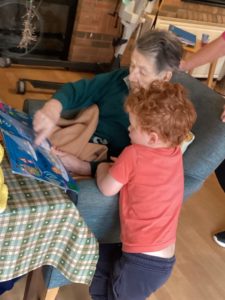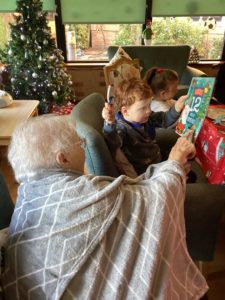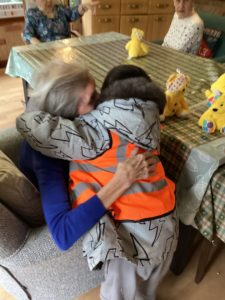“Intergenerational practice aims to bring people together in purposeful, mutually beneficial activities which promote greater understanding and respect between generations and contributes to building more cohesive communities.” – Bringing Generations Together (Care Inspectorate, 2019)
Intergenerational practice is not a new concept. People of different ages often speak of the enjoyment and the benefits of being together, getting to know one another,
learning from each other and having fun. Age often doesn’t mean a thing when they get together.
Spending time with other generations also has a wider impact. It helps us to strengthen and regenerate our communities by promoting inclusion and understanding. This, in turn, helps us to make our communities happier and more vibrant places to live and work.
At Overlee Family Centre we have made friends at Eastwood Court Care Home and have created a ‘Grandbuddies’ system. We love spending time together and learning all about what we are interested in.

Our plans for the future are
A virtual sing-a-long
A play dough day
Halloween ‘Trick or Treat’ Special
Creative day
Christmas Carol Singing
Christmas Card Making
Flower Arranging Class

BENEFITS FOR OLDER ADULTS:
1. Energizing Adults to provide feelings of invigoration, better general health and well-being.
Intergenerational activities have been proven to energize older adults and give a sense of purpose, especially when they’re sharing their experience and skills. Working with children can even have health benefits for the elderly. According to Generations Unlimited, older adults who regularly volunteer with children burn more calories per week, experience fewer falls, and do better on memory tests than their peers.
2. Reduced sense of isolation
Shared activities across generations can also reduce a sense of isolation for older adults and potentially relieve or lessen depression. We know that loneliness and depression are a big concern for today’s seniors. By providing a way for seniors to interact with younger generations, they afford the opportunity to build lasting relationships.
3. An increase in physical, mental, and creative activity.
Brighter Bervie is a voluntary gardening group that hosts intergenerational activities in Inverbervie, Aberdeenshire. Since 2018 the reported positive impact for older people included a sense of enjoyment, new friendships and increased physical activity levels. Older people felt sharing their life’s experiences and stories to the young generation was rewarding and they enjoyed hearing about the children’s newly-learned knowledge.
The project was evaluated through observation, photography, and by asking questions from the participants informally. The organisers observed that both younger and older people undertook more physical activity by being part of the project. (www.iriss.org.uk/)
4. Improvement in brain function.
Evidence shows that new brain connections can be created in older people when learning a new skill.
Older adults, including those with dementia and similar cognitive impairments, have been shown to have improved memory and a more positive outlook as a result of interacting with young children. Children also benefit hugely from the unconditional attention a relationship with an older person can provide – improved confidence and communication skills are seen, vocabulary improves, social barriers are broken down. It’s a win-win scenario!
5. Feeling less isolated, empty, or lonely.
Reported impact on older participants include:
Increased mobility and flexibility which can reduce the incidence of falls
Increased incidences of laughter and singing which could increase wellbeing
Remembering old skills e.g. playing a musical instrument, knitting, and other crafts which could be linked with a sense of value
Learning new skills e.g. computer games
Benefits For Children:
6. Helping younger participants understand aging
One of the great benefits for our younger participants is how these activities help younger generations understand aging and face their own more positively. One example is The Learning Centre at The Palms of Largo, a community managed by The Goodman Group in Florida. Here children and their “grandfriends” interact daily. The children see residents using assistive devices like walkers and wheelchairs on a regular basis, dispelling any concerns or fears they may have. It also “gives teachers the opportunity to explain what those devices are for and how they help. It lets the children know that there’s nothing to be afraid of or uncomfortable about aging or disabilities. It also reassures them that their older friends are being well cared for and loved.”
7. Learning values and norms, and how to interact with older people from different backgrounds.
Intergenerational programmes involve bringing children or young people and older adults together with the aim of improving intergenerational relationships (Chua et al 2013; Gaggioli et al 2014). Often, the focus of programmes is to change young people’s attitudes towards older adults, although some projects consider the attitudes of, and implications for, older adults themselves (Drury et al 2017). Drury et al’s review found that intergenerational contact is linked with several positive behaviours and less likelihood among young people of stereotyping and aging anxiety.
8. Development of teamwork skills.
Collaborating and sharing ideas with others helps to develop skills that assist with working with others. Listening to and understanding different points of view is a valuable lesson for appreciating we can all add value and contribute.
Wider Benefits:
The positive effects of these relationships are tangible for both age groups, but also pay dividends for the wider community
9. A better connection between generations helping to build bridges and close gaps.
Intergenerational activities can help different age groups relate to and value one another – reducing ageism, breaking down stereotypes, and increasing empathy.
10. An improved social bond and solidarity between young and old.
“This is my friend Jean and I like to visit her“- G aged 4 years


